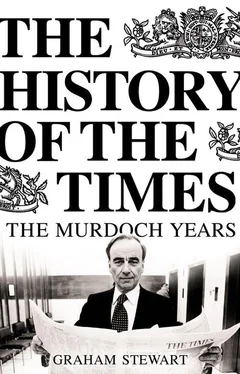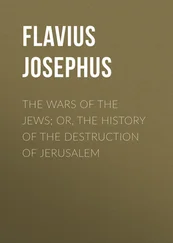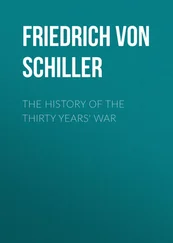Michael Binyon had been The Times ’s man in Moscow. Urbane, with the manner of the British diplomats with whom he spent so much of his time, the Cambridge-educated Binyon had arrived in the Soviet capital with his wife and three-year-old child in 1978. Extraordinarily, the paper had had no Moscow correspondent since 1972, a consequence of Soviet obstruction and a serious handicap to the paper’s pretensions as a world paper of record. Yet, as Binyon discovered, ‘the Russians had a great respect for The Times . They thought it was the official voice of Britain in the same way that Pravda is for the Soviet Union. They took it very seriously.’ [403] Michael Binyon, quoted in TNL News , September 1982.
There was virtually no night life in Moscow, only endless ambassadorial receptions. Binyon had the distinction of being touched out of a photograph published in Izvestia at a reception for Michael Foot. He was more readily recognized for his work at the British Press Awards in 1981, when he picked up the David Holden prize. According to the judges, his reporting from the Soviet Union had been ‘one of the joys of the year. He combines hard reporting, descriptive writing and highly significant detail.’ Such observation filled his subsequent book, Life in Russia . But in mid-1982 he was moved on to become the paper’s Bonn correspondent. His replacement in Moscow was Richard Owen. Owen was thirty-four and had been at The Times for only two years, having previously gained a Ph.D. from the LSE and worked for the BBC. He spoke Russian, German, French and some Polish. He was still settling in Moscow when the Tass news agency confirmed Brezhnev’s death after eighteen years at the superpower’s helm. ‘When the end came, and it had been coming for a long time,’ reported Owen ‘the Soviet leadership seemed temporarily paralysed.’ The previous day The Times had led with the headline ‘Rumours of top leader’s death sweep Moscow’, based on Owen’s observations that ‘television schedules were changed without explanation and television news readers appeared dressed in black’. With the official confirmation, The Times went through its usual motions: page six cleared for a full-page obituary – ‘President Brezhnev: consolidator of Soviet power’ – while on the following page Owen assessed the runners and riders. ‘One of the main weaknesses of the Soviet system,’ he stressed, ‘is that it makes no provision for political succession.’ Konstantin Chernenko was the favourite followed by Yuri Andropov, while, of the less likely contenders, ‘Michael Sergeyevich Gorbachov is perhaps the most interesting Politburo member in the long term … He is confident, quiet, efficient, and biding his time.’ [404] The Times , 12 November 1982.
In the event, Andropov pipped Chernenko, The Times trying to find the crumb of comfort that, having been head of the KGB for fifteen years, he would at least know what was going on in the country. [405] ‘Enter Mr Andropov’, leading article, The Times , 13 November 1982.
Fifteen months later, Owen was again prophesying a successor when Andropov died in February 1984 (he had not been seen in public since the previous August). The obituary had no option but to focus on his professional CV since – despite being at the forefront of Soviet politics for so many years – details such as whether he had a wife remained unknown (he did, but she made her first public appearance in the wake of his funeral). This time it was the seventy-two-year-old Chernenko who succeeded.
The West’s tense relations with the teetering old men of the Kremlin formed the backdrop to the most important non-party political movement of the early 1980s, the Campaign for Nuclear Disarmament. In Britain, the particular rallying call was the arrival of ninety-six US cruise missiles at the Greenham Common air base in Cambridgeshire. A hard core of women ‘peace protestors’ had been camping out at the air base for fifteen months when, on 12 December 1982, they were joined by a mass demonstration of thirty thousand women who linked hands and circled the perimeter wire of the base. With flowers and poems being inserted in the wire, the tone of the protest harked back to the ‘make love not war’ hippy movement of the late 1960s, although the women-only nature of the demonstration reduced, to some extent, the opportunities for hedonism available. There were sixty arrests. A CND demonstration outside Parliament led to 141 arrests. Douglas-Home was not much impressed, but the huge scale of national unease over the deployment of US nuclear weapons could not be so easily dismissed as an offshoot of a particular strain of feminism. Uncertainty about the power struggle in Moscow and dislike for the gun-totting tough talk of the ex-Hollywood cowboy (as his detractors so frequently described him) Ronald Reagan produced a broad coalition which feared that the sober reality of MAD (mutually assured destruction) would prove insufficient deterrence against either side attempting a first strike. With Monsignor Bruce Kent as its general secretary, CND drew particular support from many Church groups and individuals. When The Church and the Bomb , a report by the Church of England’s working party, argued that the retention of Britain’s nuclear deterrent was immoral, the editor’s brand of muscular Christianity rose to the fore: ‘The immorality of possessing nuclear weapons with the improbable intention of using them is only a small fraction of the immorality of actually using them. Set that against the certain rather than probable moral benefits of sustained peace in Europe, and the working party’s case falls down.’ [406] ‘The Morality of Deterrence’, leading article, The Times , 19 October 1982.
The 1982 Labour Party conference voted for the third year in succession in favour of Britain’s unilateral nuclear disarmament. The motion, put forward by the SOGAT ’82 print union, gained the necessary two-thirds majority to ensure it was binding on party policy (it had, in any case, the support of the party leader). It called for ‘developing with the trade union movement a detailed programme for the conversion of the relevant parts of the arms industry to the manufacture of socially-useful products so that no compulsory redundancy should arise from this policy.’ Truly, the party was committed to turning swords into ploughshares. Few on the editorial floor at Gray’s Inn Road doubted the ability of SOGAT to master the art of turning sophisticated technology into labour-intensive machinery.
Like Rupert Murdoch, Harold Evans had been broadly sympathetic towards Israel, putting on record his doubts about some of his leader writers’ wish to endorse a Palestinian state at a time when the PLO was not prepared to acknowledge the state of Israel. He had been up against the pro-Palestinian view of, in particular, Edward Mortimer, a leader writer and foreign specialist at The Times since 1973. An Old Etonian, Balliol man and fellow of All Souls, Mortimer’s history of Islam, Faith and Power , was published in 1982. Rather pointedly, he stuck up a pro-Palestinian poster in his office. [407] Harold Evans to Owen Hickey, Richard Owen, Brian Horton, 5 November 1981, Evans Day File; Harold Evans, Good Times, Bad Times , p. 237.
He would later become chief speech writer to the Secretary-General of the UN, Kofi Annan. In June 1982, The Times affirmed its commitment to an independent Palestinian state: ‘Lebanon for the Lebanese, must be the slogan; Israel for the Israelis; and a Palestine of some sort, west of Jordan, for the Palestinians.’ [408] ‘Lebanon for the Lebanese’, leading article, The Times , 14 June 1982.
Читать дальше












